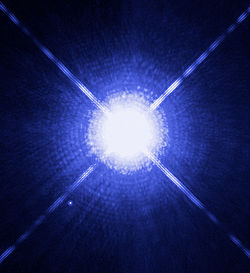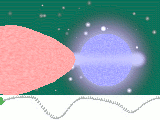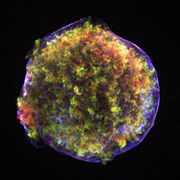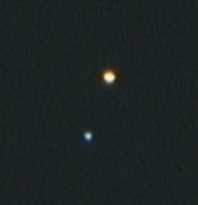
Binary star
About this schools Wikipedia selection
This wikipedia selection has been chosen by volunteers helping SOS Children from Wikipedia for this Wikipedia Selection for schools. A good way to help other children is by sponsoring a child
A binary star is a stellar system consisting of two stars orbiting around their centre of mass. For each star, the other is its companion star. Recent research suggests that a large percentage of stars are part of systems with at least two stars. Binary star systems are very important in astrophysics, because observing their mutual orbits allows their mass to be determined. The masses of many single stars can then be determined by extrapolations made from the observation of binaries.
Binary stars are not the same as optical double stars, which appear to be close together as seen from Earth, but may not be bound noticeably by gravity. Binary stars can either be distinguished optically (visual binaries) or by indirect techniques, such as spectroscopy. If binaries happen to orbit in a plane containing our line of sight, they will eclipse each other; these are called eclipsing binaries.
Systems consisting of more than two components, known as multiple stars, are also not uncommon and are generally classified under the same name. The components of binary star systems can exchange mass, bringing their evolution to stages that single stars cannot attain. Examples of binaries are Algol (an eclipsing binary), Sirius, and Cygnus X-1 (of which one member is probably a black hole).
Terminology
The term binary star was coined by Sir William Herschel in 1802 to designate, in his definition, "a real double star - the union of two stars that are formed together in one system by the laws of attraction". Any two closely-spaced stars might appear to be a double star, the most famous case being Mizar and Alcor in the Big Dipper ( Ursa Major). It is however possible that a double star is merely a star pair that only looks like a binary system: the two stars can in reality be widely separated in space, but just happen to lie in roughly the same direction as seen from Earth. Such false binaries are termed optical binaries, or optical pairs. With the invention of the telescope, many such pairs were found. Herschel, in 1780, measured the separation and orientations of over 700 pairs that appeared to be binary systems, and found that about 50 pairs changed orientation over two decades of observation.
A true binary is a pair of stars bound together by gravity. When they can be resolved (distinguished) with a powerful enough telescope (if necessary with the aid of interferometric methods) they are known as visual binaries. In other cases, the only indication is the Doppler shift of the emitted light. Systems in which this is the case, known as spectroscopic binaries, consist of relatively close pairs of stars where the spectral lines in the light from each one shifts first toward the blue, then toward the red, as each moves first toward us, and then away from us, during its motion about their common centre of mass, with the period of their common orbit. If the orbital plane is very nearly along our line of sight, the two stars partially or fully occult each other regularly, and the system is called an eclipsing binary, of which Algol is the best-known example.
Binary stars that are both visual and spectroscopic binaries are rare, and are a precious source of valuable information when found. Visual binary stars often have large true separations, with periods measured in decades to centuries; consequently, they usually have orbital speeds too small to be measured spectroscopically. Conversely, spectroscopic binary stars move fast in their orbits because they are close together; usually too close to be detected as visual binaries. Binaries that are both visual and spectroscopic thus must be relatively close to Earth.
Astronomers have discovered some stars that seem to orbit around an empty space. Astrometric binaries are relatively nearby stars which can be seen to wobble around a middle point, with no visible companion. With some spectroscopic binaries, there is only one set of lines shifting back and forth. The same mathematics used for ordinary binaries can be applied to infer the mass of the missing companion. The companion could be very dim, so that it is currently undetectable or masked by the glare of its primary, or it could be an object that emits little or no electromagnetic radiation, for example a neutron star. In some instances, there is strong evidence that the missing companion is in fact a black hole: a body with such strong gravity that no light is able to escape. Such binaries are known as high-mass X-ray binaries. Probably the best known example at present is Cygnus X-1, where the mass of the unseen companion is believed to be about nine times that of our sun; far exceeding the Tolman-Oppenheimer-Volkoff limit (the maximum theoretical mass of a neutron star, the only other likely candidate for the companion). In this way, Cygnus X-1 became the first object that was widely accepted as being a black hole.
Classifications
By methods of observation
Binary stars are classified into four types according to their observable properties. Any binary star can belong to several of these classes; for example, several spectroscopic binaries are also eclipsing binaries.
Visual binaries
A visual binary star is a binary star for which the angular separation between the two components is great enough to permit them to be observed as a double star in a telescope. The resolving power of the telescope is an important factor in the detection of visual binaries, and as telescopes become larger and more powerful an increasing number of visual binaries will be detected. The brightness of the two stars is also an important factor, as brighter stars are harder to separate due to their glare than dimmer ones are.
The brighter star of a visual binary is the primary star, and the dimmer is considered the secondary. In some publications (especially older ones), a faint secondary is called the comes; if the stars are the same brightness, the discoverer "chooses" the primary. The position angle of the secondary with respect to the primary is measured, together with the angular distance between the two stars. The time of observation is also recorded. After a sufficient number of observations are recorded over a period of time, they are plotted in polar coordinates with the primary star at the origin, and the most probable ellipse is drawn through these points such that the Keplerian law of areas is satisfied. This ellipse is known as the apparent ellipse, and is the projection of the actual elliptical orbit of the secondary with respect to the primary on the plane of the sky. From this projected ellipse the complete elements of the orbit may be computed, with the semi-major axis being expressed in angular units unless the stellar parallax, and hence the distance, of the system is known.
Spectroscopic binaries
A spectroscopic binary star is a binary star in which the separation between the stars is usually very small, and the orbital velocity very high. Unless the plane of the orbit happens to be perpendicular to the line of sight, the orbital velocities will have components in the line of sight and the observed radial velocity of the system will vary periodically. Since radial velocity can be measured with a spectrometer by observing the Doppler shift of the stars' spectral lines, the binaries detected in this manner are known as spectroscopic binaries. Most of these cannot be resolved as a visual binary, even with telescopes of the highest existing resolving power.
In some spectroscopic binaries, spectral lines from both stars are visible and the lines are alternately double and single. Such a system is known as a double-lined spectroscopic binary (often denoted "SB2"). In other systems, the spectrum of only one of the stars is seen and the lines in the spectrum shift periodically towards the blue, then towards red and back again. Such stars are known as single-lined spectroscopic binaries ("SB1").
The orbit of a spectroscopic binary is determined by making a long series of observations of the radial velocity of one or both components of the system. The observations are plotted against time, and from the resulting curve a period is determined. If the orbit is circular then the curve will be a sine curve. If the orbit is elliptical, the shape of the curve will depend on the eccentricity of the ellipse and the orientation of the major axis with reference to the line of sight.
It is impossible to determine individually the semi-major axis a and the inclination of the orbit plane i. However, the product of the semi-major axis and the sine of the inclination (i.e. a sin i) may be determined directly in linear units (e.g. kilometres). If either a or i can be determined by other means, as in the case of eclipsing binaries, a complete solution for the orbit can be found.
Eclipsing binaries
An eclipsing binary star is a binary star in which the orbit plane of the two stars lies so nearly in the line of sight of the observer that the components undergo mutual eclipses. In the case where the binary is also a spectroscopic binary and the parallax of the system is known, the binary is quite valuable for stellar analysis.
In the last decade, measurement of eclipsing binaries' fundamental parameters has become possible with 8 meter class telescopes. This makes it feasible to use them as standard candles. Recently, they have been used to give direct distance estimates to the LMC, SMC, Andromeda Galaxy and Triangulum Galaxy. Eclipsing binaries offer a direct method to gauge the distance to galaxies to a new improved 5% level of accuracy.
Eclipsing binaries are variable stars, not because the light of the individual components vary but because of the eclipses. The light curve of an eclipsing binary is characterized by periods of practically constant light, with periodic drops in intensity. If one of the stars is larger than the other, one will be obscured by a total eclipse while the other will be obscured by an annular eclipse.
The period of the orbit of an eclipsing binary may be determined from a study of the light curve, and the relative sizes of the individual stars can be determined in terms of the radius of the orbit by observing how quickly the brightness changes as the disc of the near star slides over the disc of the distant star. If it is also a spectroscopic binary the orbital elements can also be determined, and the mass of the stars can be determined relatively easily, which means that the relative densities of the stars can be determined in this case.
Astrometric binaries
An astrometric binary star is a binary star for which only one of the component stars can be visually observed. The visible star's position is carefully measured and detected to have a wobble, due to the gravitational influence from its counterpart. The position of the star is repeatedly measured relative to more distant stars, and then checked for periodic shifts in position. Typically this type of measurement can only be performed on nearby stars, such as those within 10 parsecs. Nearby stars often have a relatively high proper motion, so astrometric binaries will appear to follow a sinusoidal path across the sky.
If the companion is sufficiently massive to cause an observable shift in position of the star, then its presence can be deduced. From precise astrometric measurements of the movement of the visible star over a sufficiently long period of time, information about the mass of the companion and its orbital period can be determined. Even though the companion is not visible, the characteristics of the system can be determined from the observations using Kepler's laws.
This method of detecting binaries is also used to locate extrasolar planets orbiting a star. However, the requirements to perform this measurement are very exacting, due to the great difference in the mass ratio, and the typically long period of the planet's orbit. Detection of position shifts of a star is a very exacting science, and it is difficult to achieve the necessary precision. Space telescopes can avoid the bluring effect of the Earth's atmosphere, resulting in more precise resolution.
By configuration of the system
Another classification is based on the distance of the stars, relative to their sizes:
Detached binaries are a kind of binary stars where each component is within its Roche lobe, i.e. the area where the gravitational pull of the star itself is larger than that of the other component. The stars have no major effect on each other, and essentially evolve separately. Most binaries belong to this class.
Semidetached binary stars are binary stars where one of the components fills the binary star's Roche lobe and the other does not. Gas from the surface of the Roche lobe filling component (donor) is transferred to the other, accreting star. The mass transfer dominates the evolution of the system. In many cases, the inflowing gas forms an accretion disc around the accretor. Examples of this type are X-ray binaries and Cataclysmic variable stars.
A contact binary is a type of binary star in which both components of the binary fill their Roche lobes. The uppermost part of the stellar atmospheres forms a common envelope that surrounds both stars. As the friction of the envelope brakes the orbital motion, the stars may eventually merge.
Binary star evolution
Formation
While it is not impossible that some binaries might be created through gravitational capture between two single stars, given the very low likelihood of such an event (three objects are actually required, as conservation of energy rules out a single gravitating body capturing another) and the high number of binaries, this cannot be the primary formation process. Also, the observation of binaries consisting of pre main sequence stars, supports the theory that binaries are already formed during star formation. Fragmentation of the molecular cloud during the formation of protostars is an acceptable explanation for the formation of a binary or multiple star system.
The outcome of the three body problem, where the three stars are of comparable mass, is that eventually one of the three stars will be ejected from the system and, assuming no significant further perturbations, the remaining two will form a stable binary system.
Mass transfer and accretion
As a main sequence star increases in size during its evolution, it may at some point exceed its Roche lobe, meaning that some of its matter ventures into a region where the gravitational pull of its companion star is larger than its own. The result is that matter will transfer from one star to another through a process known as Roche Lobe overflow (RLOF), either being absorbed by direct impact or through an accretion disc. The mathematical point through which this transfer happens is called the first Lagrangian point. It is not uncommon that the accretion disc is the brightest (and thus sometimes the only visible) element of a binary star.
If a star grows outside of its Roche lobe too fast for all abundant matter to be transferred to the other component, it is also possible that matter will leave the system through other Lagrange points or as stellar wind, thus being effectively lost to both components. Since the evolution of a star is determined by its mass, the process influences the evolution of both companions, and creates stages that can not be attained by single stars.
Studies of the eclipsing ternary Algol led to the Algol paradox in the theory of stellar evolution: although components of a binary star form at the same time, and massive stars evolve much faster than the less massive ones, it was observed that the more massive component Algol A is still in the main sequence, while the less massive Algol B is a subgiant star at a later evolutionary stage. The paradox can be solved by mass transfer: when the more massive star became a subgiant, it filled its Roche lobe, and most of the mass was transferred to the other star, which is still in the main sequence. In some binaries similar to Algol, a gas flow can actually be seen.
Runaways and novae
It is also possible for widely separated binaries to lose gravitational contact with each other during their lifetime, as a result of external perturbations. The components will then move on to evolve as single stars. A close encounter between two binary systems can also result in the gravitational disruption of both systems, with some of the stars being ejected at high velocities, leading to runaway stars.
If a white dwarf has a close companion star that overflows its Roche lobe, the white dwarf will steadily accrete gases from the star's outer atmosphere. These are compacted on the white dwarf's surface by its intense gravity, compressed and heated to very high temperatures as additional material is drawn in. The white dwarf consists of degenerate matter, and so is largely unresponsive to heat, while the accreted hydrogen is not. Hydrogen fusion can occur in a stable manner on the surface through the CNO cycle, causing the enormous amount of energy liberated by this process to blow the remaining gases away from the white dwarf's surface. The result is an extremely bright outburst of light, known as a nova.
In extreme cases this event can cause the white dwarf to exceed the Chandrasekhar limit and trigger a supernova that destroys the entire star, and is another possible cause for runaways. A famous example of such an event is the supernova SN 1572, which was observed by Tycho Brahe. The Hubble Space Telescope recently took a picture of the remnants of this event.
Use in astrophysics

Binaries provide the best method for astronomers to determine the mass of a distant star. The gravitational pull between them causes them to orbit around their common centre of mass. From the orbital pattern of a visual binary, or the time variation of the spectrum of a spectroscopic binary, the mass of its stars can be determined. In this way, the relation between a star's appearance (temperature and radius) and its mass can be found, which allows for the determination of the mass of non-binaries.
Because a large proportion of stars exist in binary systems, binaries are particularly important to our understanding of the processes by which stars form. In particular, the period and masses of the binary tell us about the amount of angular momentum in the system. Because this is a conserved quantity in physics, binaries give us important clues about the conditions under which the stars were formed.
In a binary system, the more massive star is usually designated 'A', and its companion 'B'. Thus the bright main sequence star of the Sirius system is Sirius A, while the smaller white dwarf member is Sirius B. However, if the pair is very widely separated, they may be designated with superscripts as with Zeta Reticuli (ζ1 Ret and ζ2 Ret).
Research findings
It is believed that up to seventy-five percent of all stars are in binary systems, with as many as 10% of these systems containing more than two stars (triples, quadruples, etc.).
There is a direct correlation between the period of revolution of a binary star and the eccentricity of its orbit, with systems of short period having smaller eccentricity. Binary stars may be found with any conceivable separation, from pairs orbiting so closely that they are practically in contact with each other, to pairs so distantly separated that their connection is indicated only by their common proper motion through space. Among gravitationally bound binary star systems, there exists a so called log normal distribution of periods, with the majority of these systems orbiting with a period of about 100 years. This is supporting evidence for the theory that binary systems are formed during star formation.
In pairs where the two stars are of equal brightness, they are also of the same spectral type. In systems where the brightnesses are different, the fainter star is bluer if the brighter star is a giant star, and redder if the brighter star belongs to the main sequence.
Since mass can be determined only from gravitational attraction, and the only stars (with the exception of the Sun, and gravitationally-lensed stars), for which this can be determined are binary stars, these are a uniquely important class of stars. In the case of a visual binary star, after the orbit and the stellar parallax of the system has been determined, the combined mass of the two stars may be obtained by a direct application of the Keplerian harmonic law.
Unfortunately, it is impossible to obtain the complete orbit of a spectroscopic binary unless it is also a visual or an eclipsing binary, so from these objects only a determination of the joint product of mass and the sine of the angle of inclination relative to the line of sight is possible. In the case of eclipsing binaries which are also spectroscopic binaries, it is possible to find a complete solution for the specifications (mass, density, size, luminosity, and approximate shape) of both members of the system.
Planets around binary stars
Science fiction has often featured planets of binary or ternary stars as a setting. In reality, some orbital ranges are impossible for dynamical reasons (the planet would be expelled from its orbit relatively quickly, being either ejected from the system altogether or transferred to a more inner or outer orbital range), whilst other orbits present serious challenges for eventual biospheres because of likely extreme variations in surface temperature during different parts of the orbit. Planets that orbit just one star in a binary pair are said to have "S-type" orbits, whereas those that orbit around both stars have "P-type" or "circumbinary" orbits. It is estimated that 50–60% of binary stars are capable of supporting habitable terrestrial planets within stable orbital ranges.
Simulations have shown that the presence of a binary companion can actually improve the rate of planet formation within stable orbital zones by "stirring up" the protoplanetary disk, increasing the accretion rate of the protoplanets within.
Detecting planets around multiple star systems introduces additional technical difficulties, which may be why they are only rarely found. Examples include PSR B1620-26c and HD 188753 Ab, the latter being the only known planet in a ternary system as of 2006.
Multiple star examples
The large distance between the components, as well as their difference in colour, make Albireo one of the easiest observable visual binaries. The brightest member, which is the third brightest star in the constellation Cygnus, is actually a close binary itself. Also in the Cygnus constellation is Cygnus X-1, an X-ray source considered to be a black hole. It is a high-mass X-ray binary, with the optical counterpart being a variable star. Another famous binary is Sirius, the brightest star in the night time sky, with a visual apparent magnitude of −1.46. It is located in the constellation Canis Major. In 1844 Friedrich Bessel deduced that Sirius was a binary. In 1862 Alvan Graham Clark discovered the companion (Sirius B; the visible star is Sirius A). In 1915 astronomers at the Mount Wilson Observatory determined that Sirius B was a white dwarf, the first to be discovered. In 2005, using the Hubble Space Telescope, astronomers determined Sirius B to be 12,000 km in diameter, with a mass that is 98% of the Sun.
An example of an eclipsing binary is Epsilon Aurigae in the constellation Auriga. The visible component belongs to the spectral class F0, the other (eclipsing) component is not visible. The next such eclipse occurs from 2009–2011, and it is hoped that the extensive observations that will likely be carried out may yield further insights into the nature of this system. Another eclipsing binary is Beta Lyrae, which is a contact binary star system in the constellation of Lyra. Its two component stars are close enough that material from the photosphere of each is pulled towards the other, drawing the stars into an ellipsoid shape. Beta Lyrae is the prototype for this class of eclipsing binaries, whose components are so close together that they deform by their mutual gravitation.
Other interesting binaries include 61 Cygni (a binary in the constellation Cygnus, composed of two K class (orange) main sequence stars, 61 Cygni A and 61 Cygni B, which is known for its large proper motion), Procyon (the brightest star in the constellation Canis Minor and the eighth brightest star in the night time sky, which is a binary consisting of the main star with a faint white dwarf companion), SS Lacertae (an eclipsing binary which stopped eclipsing), V907 Sco (an eclipsing binary which stopped, restarted, then stopped again) and BG Geminorum (an eclipsing binary which is thought to contain a black hole with a K0 star in orbit around it).
Algol is the most famous ternary (long thought to be a binary), located in the constellation Perseus. Two components of the system eclipse each other, the variation in the intensity of Algol first being recorded in 1670 by Geminiano Montanari. The name Algol means "demon star" (from Arabic الغول al-ghūl), which was probably given due to its peculiar behaviour. Another visible ternary is Alpha Centauri, in the southern constellation of Centaurus, which contains the fourth brightest star in the night sky, with an apparent visual magnitude of −0.01. This system also underscores the fact that binaries need not be discounted in the search for habitable planets. Centauri A and B have an 11 AU distance at closest approach, and both should have stable habitable zones.
There are also examples of systems beyond ternaries: Castor is a sextuple star system, which is the second brightest star in the constellation Gemini and one of the brightest stars in the nighttime sky. Astronomically, Castor was discovered to be a visual binary in 1719. Each of the components of Castor is itself a spectroscopic binary. Castor also has a faint and widely separated companion, which is also a spectroscopic binary.








